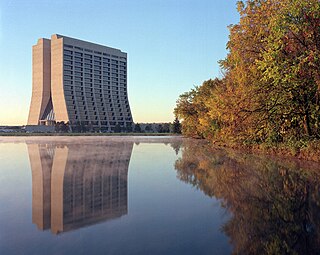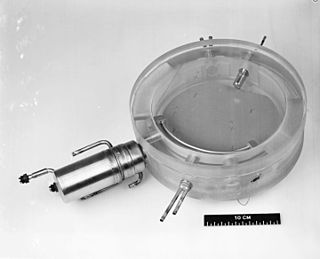
A bubble chamber is a vessel filled with a superheated transparent liquid used to detect electrically charged particles moving through it. It was invented in 1952 by Donald A. Glaser, for which he was awarded the 1960 Nobel Prize in Physics. Supposedly, Glaser was inspired by the bubbles in a glass of beer; however, in a 2006 talk, he refuted this story, although saying that while beer was not the inspiration for the bubble chamber, he did experiments using beer to fill early prototypes.

The Compact Muon Solenoid (CMS) experiment is one of two large general-purpose particle physics detectors built on the Large Hadron Collider (LHC) at CERN in Switzerland and France. The goal of the CMS experiment is to investigate a wide range of physics, including the search for the Higgs boson, extra dimensions, and particles that could make up dark matter.

Donald Arthur Glaser was an American physicist, neurobiologist, and the winner of the 1960 Nobel Prize in Physics for his invention of the bubble chamber used in subatomic particle physics.

A cloud chamber, also known as a Wilson chamber, is a particle detector used for visualizing the passage of ionizing radiation.

Gargamelle was a heavy liquid bubble chamber detector in operation at CERN between 1970 and 1979. It was designed to detect neutrinos and antineutrinos, which were produced with a beam from the Proton Synchrotron (PS) between 1970 and 1976, before the detector was moved to the Super Proton Synchrotron (SPS). In 1979 an irreparable crack was discovered in the bubble chamber, and the detector was decommissioned. It is currently part of the "Microcosm" exhibition at CERN, open to the public.
A wire chamber or multi-wire proportional chamber is a type of proportional counter that detects charged particles and photons and can give positional information on their trajectory, by tracking the trails of gaseous ionization. The technique was an improvement over the bubble chamber particle detection method, which used photographic techniques, as it allowed high speed electronics to track the particle path.

The LHCb experiment is a particle physics detector experiment collecting data at the Large Hadron Collider at CERN. LHCb is a specialized b-physics experiment, designed primarily to measure the parameters of CP violation in the interactions of b-hadrons. Such studies can help to explain the matter-antimatter asymmetry of the Universe. The detector is also able to perform measurements of production cross sections, exotic hadron spectroscopy, charm physics and electroweak physics in the forward region. The LHCb collaborators, who built, operate and analyse data from the experiment, are composed of approximately 1650 people from 98 scientific institutes, representing 22 countries. Vincenzo Vagnoni succeeded on July 1, 2023 as spokesperson for the collaboration from Chris Parkes. The experiment is located at point 8 on the LHC tunnel close to Ferney-Voltaire, France just over the border from Geneva. The (small) MoEDAL experiment shares the same cavern.

The Collider Detector at Fermilab (CDF) experimental collaboration studies high energy particle collisions from the Tevatron, the world's former highest-energy particle accelerator. The goal is to discover the identity and properties of the particles that make up the universe and to understand the forces and interactions between those particles.

ALICE is one of nine detector experiments at the Large Hadron Collider at CERN. The experiment is designed to study the conditions that are thought to have existed immediately after the Big Bang by measuring the properties of quark-gluon plasma.

The Proton Synchrotron is a particle accelerator at CERN. It is CERN's first synchrotron, beginning its operation in 1959. For a brief period the PS was the world's highest energy particle accelerator. It has since served as a pre-accelerator for the Intersecting Storage Rings (ISR) and the Super Proton Synchrotron (SPS), and is currently part of the Large Hadron Collider (LHC) accelerator complex. In addition to protons, PS has accelerated alpha particles, oxygen and sulfur nuclei, electrons, positrons, and antiprotons.
George Ernest Kalmus, CBE, FRS is a noted British particle physicist.

MACRO was a particle physics experiment located at the Laboratori Nazionali del Gran Sasso in Abruzzo, Italy. MACRO was proposed by 6 scientific institutions in the United States and 6 Italian institutions.

The Big European Bubble Chamber (BEBC) is a large detector formerly used to study particle physics at CERN. The chamber body, a stainless-steel vessel, was filled with 35 cubic metres of superheated liquid hydrogen, liquid deuterium, or a neon-hydrogen mixture, whose sensitivity was regulated by means of a movable piston weighing 2 tons. The liquids at typical operation temperatures around 27 K were placed under overpressure of about 5 standard atmospheres (510 kPa). The piston expansion, synchronized with the charged particle beam crossing the chamber volume, caused a rapid pressure drop; in consequence the liquid reached its boiling point. During each expansion, charged particles ionized the atoms of the liquid as they passed through it and the energy deposited by them initiated boiling along their path, leaving trails of tiny bubbles. These tracks were photographed by the five cameras mounted on top of the chamber. The stereo photographs were subsequently scanned and all events finally evaluated by a team of scientists. After each expansion, the pressure was increased again to stop the boiling. The bubble chamber was then ready again for a new cycle of beam exposure.

The NA62 experiment is a fixed-target particle physics experiment in the North Area of the SPS accelerator at CERN. The experiment was approved in February 2007. Data taking began in 2015, and the experiment is expected to become the first in the world to probe the decays of the charged kaon with probabilities down to 10−12. The experiment's spokesperson is Giuseppe Ruggiero. The collaboration involves 308 participants from 33 institutions and 16 countries around the world.
A liquid metal ion source (LMIS) is an ion source which uses metal that is heated to the liquid state and used to form an electrospray to form ions. An electrospray Taylor cone is formed by the application of a strong electric field and ions are produced by field evaporation at the sharp tip of the cone, which has a high electric field. Ions from a LMIS are used in ion implantation and in focused ion beam instruments. Typically gallium is preferred for its low melting point, low vapor pressure, its relatively unreactive nature, and because the gallium ion is sufficiently heavy for ion milling.
The Holographic Lexan Bubble Chamber, HOLEBC, was a hydrogen bubble chamber.

The 81 cm Saclay Bubble Chamber was a liquid hydrogen bubble chamber built at Saclay, in collaboration with the École Polytechnique (Orsay), to study particle physics. The team led by Bernard Gregory completed the construction of the chamber in 1960 and later it was moved to CERN and installed at the Proton Synchrotron (PS).

The construction of the LExan Bubble Chamber, LEBC, was approved by the CERN Research Board on 16 November 1978.

The 2m Bubble Chamber was a device used in conjunction with CERN’s 25 GeV Proton Synchrotron (PS) machine to study high-energy physics. It was decided to build this chamber in 1958 with a large team of physicists, engineers, technicians and designers led by Charles Peyrou. This project was of considerable magnitude, thus requiring a long-term plan so that all its characteristics could be carefully studied. Several models of this chamber were built and the problems encountered surpassed any of its predecessors. The construction only began three years later and in 1964 the chamber was finally commissioned. This chamber was devoted to the study of interaction mechanisms of high-energy particles and the investigation of the properties of their excited states.

The 30 cm Bubble Chamber, prototyped as a 10 cm Bubble Chamber, was a particle detector used to study high-energy physics at CERN.














